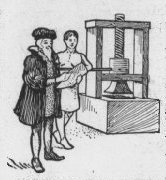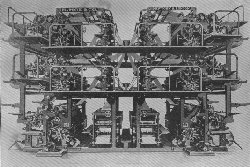In the middle of that century Gutenberg printed a book from movable types. Two upright timbers with crosspieces of wood at the top and bottom constituted the outer frame of his press. Other crosspieces held the flat bed containing the type, and through still another intermediate slot passed a wooden screw, its lower end touching the center of a platen of wood and screwing it down upon the type. The form was inked with a ball of leather stuffed with wool, upon which the paper was laid. On this paper a fragment of blanket was spread to make the platen smooth and soften the impression. The idea of the machine was based on the cheese and linen presses used in medieval households. The type of the present time is practically identical with that used by Gutenberg in printing his Bible. For about 150 years the wooden press, operated with a screw and movable bar, was used without much modification. The forms, however, sometimes rested upon stone beds held in frames styled coffins, and were moved by hand. The platen was screwed up with the bar after each impression, in order to withdraw the printed sheet and hang it up for drying. About the year 1620 this press was first improved by a printer, of Amsterdam, named William Jensen Blaew. He ran the spindle of the screw through a square block guided in the wooden frame, and by cords or wires suspended the platen from this block, which prevented the platen from twisting and equalized the motion of the screw. This press was used in England and on the continent, and was nearly identical with that operated by Benjamin Franklin when he worked as a journeyman in London. About the close of the 18th century it was found necessary, particularly in the printing of wood cuts, and because of the size of larger forms of type to secure greater power for the impression. This led the Earl of Stanhope to construct a frame of cast iron, and, to facilitate the manipulation of the screw, he added a combination of levers which enabled the pressman to bring more force to bear, with less exertion. Shortly after the year 1800, George Clymer, of Philadelphia, contrived an iron machine without a screw. Over the platen was placed a long, heavy, cast-iron lever. One end of this was fastened to an upright of the frame, and the other end was raised and lowered by a combination of smaller levers operated by the pressman in a manner similar to that of the common hand press. A spindle or pin, attached at the top, to the center of the large cross lever, and properly balanced raised and lowered the platen when making the impression. This press was used in England. Friedrich Koenig, of Saxony, introduced the first press of the above description into use in England in 1812-13, and in 1814 he patented a continuously revolving cylinder press which printed one side of a paper at the rate of 800 sheets per hour. Peter Smith, of New York, who was associated with R. Hoe & Co., contrived a cast-iron press in 1822, in which he replaced the screw and levers with a toggle joint, which simplified the operation of the machine and rendered it more effective. Smith's invention was greatly improved upon in 1827 by a device perfected by Samuel Rust, of New York, in which the frame was not all of cast-iron, but had the uprights hollowed for the introduction of wrought-iron bars fastened to the top and bottom of the casting. This feature greatly lessened the quantity of metal in the press, while adding to its strength. Rust's patent was bought by Hoe & Co., who improved it materially and manufactured and sold it extensively. In this press (the Washington) by turning a crank, with belts attached to a pulley upon its shaft, the bed is run out and in from under the platen on a track. The platen is raised by springs on each side, and a curved lever acting on a toggle joint impresses it upon the form. A tympan frame covered with cloth and inclined so as to receive the sheet of paper is attached to the bed. Another frame, the frisket, covered with a sheet of paper, is attached to the tympan. That portion of the sheet which would naturally receive an impression is cut away, as, otherwise, the chase and furniture would smear it. Over the sheet and tympan the "frisket" is turned down, and in making the impression all are folded together. The machine has automatic inking rollers, which the pressman operates by a weight. The descent of the weight draws the rollers over the type and returns them to the inking cylinder, while the pressman places another sheet upon the tympan. Hoe & Co. also improved this press by providing a steam-driven apparatus, which distributes the ink on the rollers and makes them move over the type at will. Fine books and cuts were commonly printed by the bed and platen method until 1850, the first steam-power, wooden press of this kind having been made by Daniel Treadwell, of Boston, in 1822. The next improved press of Hoe & Co. printed papers of four, six, eight, ten or twelve papers at the rate of 24,000 per hour and sixteen-page papers at 12,000 per hour, the odd pages being in every case accurately inserted and pasted in and the papers cut at the top and delivered folded. The machine is constructed in two parts, the cylinders in one portion being twice the length of those in the other. The short cylinders are used for the supplements of the paper, when it is desired to print more thin eight pages. The plates being secured on the cylinders, the paper enters from the two rolls into the two portions of the machine, through each of which it is carried by two pairs of type and impression cylinders, and printed on both sides, after which the two broad ribbons or webs pass over turning bars and other devices, by which they are laid evenly, one over the other, and pasted together. The webs of paper then pass down over a triangular "former," which folds them along the center margin. They are then taken over a cylinder, from which they receive the final fold, a revolvining blade within this cylinder projecting and thrusting the paper between folding rollers, while at the same moment a knife in the same severs the sheet and a rapidly revolving mechanism resembling in its motion the fingers of a hand causes their accurate disposal upon traveling belts, which conveys them on for final removal. What is known as the "Quadruple News, paper Press," constructed in 1887, was developed to a greater extent. The supplement portion (if the press was increased in width, and by ingenious devices the press was made to produce eight-page papers at a running speed of 48,000 per hour; also 14,000 per hour, of eight, ten, twelve, fourteen or sixteen-page papers, cut at the top and pasted and folded, ready for the carrier or the mails.
The latest and most elaborate newspaper machine is the Octuple Perfecting Press with Folders, which prints from four rolls, each four pages wide; and gives (from the four deliveries) a running speed per hour, of 96,000 four, six or eight-page papers; 72,000 ten-page papers; 60,000 twelve-page papers; 48,000 fourteen or sixteen-page papers; 42,000 eighteen-page papers; 36,000 twenty-page papers, and 24,000 twenty-four page papers. A RAILROAD ENCIRCLING THE GLOBE |

